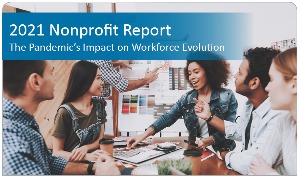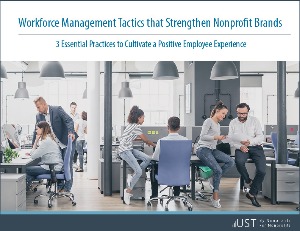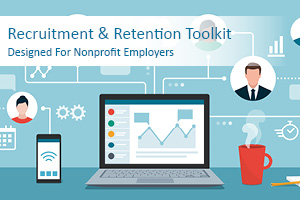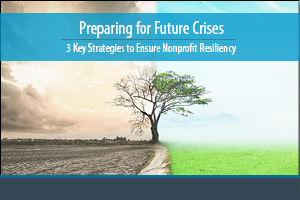
Are you curious to discover how nonprofits have pivoted strategies in response to COVID-19 and how this pandemic is causing permanent change across the sector? With over 400 survey respondents—representing a wide variety of nonprofits from across the U.S.—this report unveils the pandemic’s impact on workforce evolution and illustrates how the sector withstood the hardships caused by the crisis.
Download the report to learn:
This report will provide valuable insight on how nonprofit organizations are navigating the ongoing challenges that have arisen throughout the pandemic. For only $99, download your copy of the 2021 sector report today!

Question: Can we require remote employees to have childcare?
Answer: We do not recommend having a policy that stipulates childcare is necessary. For one thing, in practice, it often isn’t necessary. Lots of employees are able to do their jobs just fine while supervising children in the home. Imposing this requirement (and a huge financial burden) won’t solve any problems, but it may encourage remote employees to start looking for a new job. Even in cases where supervising children does negatively affect job performance, requiring childcare as a solution could be seen as crossing a line into your employees’ personal lives.
Instead of requiring childcare, we recommend setting clear expectations for attendance, availability, performance, and productivity. You can then discipline employees who don’t meet these expectations without giving the impression that you’re micromanaging their personal lives.
It’s also worth keeping in mind that employee expectations around remote work have changed. People choose remote work with the idea that they’ll have more flexibility during the day to attend to their personal responsibilities. If that flexibility isn’t an option, it’s important to make that clear so employees know what to expect.
Q&A provided by Mineral, powering the UST HR Workplace for nonprofit HR teams. Have HR questions? Sign your nonprofit up for a free 60-day trial here. As a UST member, simply log into yourMineralportal to access live HR certified consultants, 300+ on-demand training courses, an extensive compliance library, and more.

Risk management is defined as a discipline for dealing with the possibility that some future event will cause harm and nonprofit risk comes in an endless number of forms—data security, fundraising fraud, regulatory compliance, employee relations, volunteer staff, and theft just to name a few. Given the myriad of ways that nonprofits are changing the world and the impossible task of being able to predict every potential mission-disrupting event, every organization stands to benefit from risk reducing tactics. This is where risk management comes in—an essential necessity that helps nonprofits understand the threats they face and how to prioritize strategies that create sustainability in the future.
Developing a risk management process is essential to every nonprofit but many remain unprotected simply because they don’t have the funds or resources to implement such a strategy. There are however other ways to protect your organization without breaking the bank that just require more time and dedication to create and streamline. So, if you don’t have a risk management strategy in place already, now is the time to start.
Follow these four steps to create a risk management strategy:
A single liability incident can easily cost tens of thousands of dollars, not to mention the harm it can do to your reputation. In short, by taking the time to identify risks, prioritize issues, respond to the problems, assess the situation, and improve your strategy, nonprofit employers can better protect their assets and avoid future risks.

One of the biggest challenges nonprofits are faced with is the “great resignation” sparked by the pandemic—where employees are burnt out and pursuing new jobs that better align with their evolving priorities. In order to stay competitive in today’s job market, nonprofit leaders must reinvent their recruitment tactics, work-life balance initiatives and employee engagement strategies.
Don’t miss your chance to download a free copy of UST’s latest eBook, Workforce Management Tactics that Strengthen Nonprofit Brands, to discover 3 key strategies that can help your nonprofit create (and sustain) a resilient workforce.
In this eBook, you’ll discover:
This eBook will help you uncover new strategies that will encourage your current (and future) workforce to carry out your mission for years to come.

Question: Do OSHA’s regulations and standards apply to the home office? Are there any other federal laws employers need to consider when employees work from home?
Answer: The Department of Labor’s Occupational Safety and Health Administration (OSHA) does not have any regulations regarding telework in home offices. The agency issued a directive in February 2000 stating that the agency will not conduct inspections of employees’ home offices, will not hold employers liable for employees’ home offices, and does not expect employers to inspect the home offices of their employees.
If OSHA receives a complaint about a home office, the complainant will be advised of OSHA’s policy. If an employee makes a specific request, OSHA may informally let employers know of complaints about home office conditions but will not follow-up with the employer or employee.
Employers who are required to keep records of work-related injuries and illnesses will continue to be responsible for keeping such records for injuries and illnesses occurring in a home office.
The Fair Labor Standards Act (FLSA) and its implementing regulations do not prevent employers from implementing telework or other flexible work arrangements allowing employees to work from home. Employers would still be required to maintain an accurate record of hours worked for all employees, including those participating in telework or other flexible work arrangements; and to pay no less than the minimum wage for all hours worked and to pay at least one and one-half times the employee’s regular rate of pay for all hours worked over 40 in a workweek to nonexempt employees.
Employers are encouraged to work with their employees to establish hours of work for employees who telework and a mechanism for recording each teleworking employee’s hours of work. Nonexempt employees must receive the required minimum wage and overtime pay free and clear. This means that when a covered employee is required to provide the tools and equipment (e.g., computer, Internet connection, facsimile machine, etc.) needed for telework, the cost of providing the tools and equipment may not reduce the employee’s pay below that required by the FLSA.
Under the Americans with Disabilities Act (ADA), telework could be a reasonable accommodation the employer would need to provide to a qualified individual with a disability, barring any undue hardship. However, an employer may instead offer alternative accommodations as long as they would be effective.
Q&A provided by Mineral, powering the UST HR Workplace for nonprofit HR teams. Have HR questions? Sign your nonprofit up for a free 60-day trial here.

Turnover is a natural part of any nonprofit organization’s life cycle, and employee offboarding should be handled with the same degree of importance as onboarding a new employee. An offboarding plan offers an opportunity for communication and manage change, to help preserve and improve your employer brand and to generate good faith with the departing employee. There can be many moving pieces involved with a termed employee and clear offboarding procedures help manage the expectations of all parties involved.
When done correctly, the employee offboarding process can offer key management insights and reveal hidden internal issues. From a management point of view, the focus is to address issues at an organization level. Whereas, employees are faced with small issues that aren’t always noticed by managers or the executive team. Not giving attention and time to these small and recurring issues can lead to larger issues which could then impact the productivity of the organization.
Here are some best practices when creating an efficient and smooth employee offboarding process:
1) Learn why the employee is leaving: Maybe the employee wasn’t a long-term fit for your company culture, perhaps they came across a career-changing opportunity, or they weren’t a fit to handle growth gracefully. Regardless of the reason, organizations need to first understand the reason why an employee wants to leave and have a clear plan in place to handle each type of exit. Having the appropriate policies and procedures in place to handle any and all offboarding reasons are key for orchestrating a smooth departure.
2) Conduct a smooth offboarding: A crucial aspect of a good employee offboarding process is to treat employees warmly, regardless of the reason behind their departure. Creating a positive farewell will encourage employees to speak to others positively about their experience which in turn, increases the organization’s brand value. Taking the opportunity to engage departed employees will help with talent acquisition and managing the reputation of the organization’s brand.
3) Ask for feedback: When an employee leaves, it can be a valuable opportunity to collect insightful turnover data. During the exit interview, the employee can offer honest feedback about the organization since they are no longer reliant on this job for financial means. When an employee expresses their desire to leave, sending them an exit interview survey can help organizations uncover areas of opportunities that need to be addressed to improve employee engagement and productivity.
4) Avoid decreases in productivity: When an employee departs, day-to-day activities overseen by this employee will be interrupted or possibly put on pause—resulting in a decrease in productivity. Cross training with current employees can prevent a dip in productivity, such as, transferring process knowledge, document procedures and responsibilities, and login credentials for business tools.
Depending on the reason for the employee’s departure, exit interviews are an opportunity to collect important insights to improve your current offboarding strategy. The complexities involved in offboarding make saying “goodbye” to employees a challenging task—which is why consistency is the key to a successful exit interview. With the right tools in place, organizations have the ability to standardize the complexities involved in employee offboarding and help you part ways in the most efficient way.

Question: As we begin to return to work, if an employee is out of the office due to sickness, can we ask them about their symptoms?
Answer:Yes, but there’s a right way to do it and a wrong way to do it. In non-pandemic circumstances, employers shouldn’t ask about an employee’s symptoms, as that could be construed as a disability-related inquiry. Under the circumstances, however — and in line with an employer’s responsibility to provide a safe workplace — it is recommended that employers ask specifically about the symptoms of COVID-19.
Here is a suggested communication: “Thank you for staying home while sick. In the interest of keeping all employees as safe as possible, we’d like to know if you are having any of the symptoms of COVID-19. Are you experiencing a fever, cough, shortness of breath, chills, muscle pain, headache, sore throat, or a new loss of taste or smell?”
Remember that medical information must be kept confidential as required by the Americans with Disabilities Act (ADA). If the employee does reveal that they have symptoms of COVID-19, or has a confirmed case, the CDC recommends informing the employee’s co-workers of their possible exposure to COVID-19 in the workplace (but not naming the employee who has or might have it) and directing them to self-monitor for symptoms. Employers should also follow CDC guidance for cleaning and disinfecting.
Q&A provided by ThinkHR, powering the UST HR Workplace for nonprofit HR teams. Have HR questions? Sign your nonprofit up for a free 60-day trial here.

Recruiting and retaining top performers is crucial to the success of any nonprofit and when done right, reaps the best reward—employees that support and strengthen your mission-driven work. To help nonprofit employers strengthen their recruiting and retention practices—while focusing on the employee’s entire journey with the organization—we created the 2021 Recruitment and Retention Toolkit .
This free toolkit includes a recruiting checklist, workplace flexibility fundamentals, interview best practice tips, and more:
Would you like access to more HR-specific articles, templates and checklists? Sign up for a FREE 60-Day Trial of UST HR Workplace today! You’ll also gain access to live, certified HR consultants, 300+ on-demand training courses, an extensive compliance library, and more.

UST just released the latest edition of our Quarterly Nonprofit Digest. This quick reference guide highlights key findings from last quarter’s most popular content—which focused on innovative nonprofit sustainability strategies to help employers thrive in these ever evolving times.
If you’re a nonprofit leader, download your free copy of the Q2 quarterly digest to discover essential strategies for:
You’ll also gain access to helpful checklists, people risk management templates and best practice tips to help you plan (and execute) a successful virtual event.
To get more nonprofit-exclusive content, webinar invitations and sector insights delivered straight to your inbox, sign up for UST’s eNewsletter today.

UST recently published an eBook that discusses how the global pandemic challenged nonprofits in ways that were unprecedented at that time and how taking the time to develop better defenses against subsequent crises—building greater resilience against natural, economic and health threats—nonprofits can move toward a better prepared future.
This insightful eBook uncovers strategies that can help nonprofits implement a game plan that will help ensure organizational sustainability in the wake of the next disaster. Available now for download, UST’s eBook will help you protect your employees, continuity of services and the communities you serve when future challenges arise.
In this eBook, you’ll also discover:
Don’t miss your opportunity to download your complimentary copy of “Preparing for Future Crises: Strategies to Ensure Nonprofit Resiliency” to discover how to protect your nonprofit and its workforce from future crises.

UST maintains a secure site. This means that information we obtain from you in the process of enrolling is protected and cannot be viewed by others. Information about your agency is provided to our various service providers once you enroll in UST for the purpose of providing you with the best possible service. Your information will never be sold or rented to other entities that are not affiliated with UST. Agencies that are actively enrolled in UST are listed for review by other agencies, UST’s sponsors and potential participants, but no information specific to your agency can be reviewed by anyone not affiliated with UST and not otherwise engaged in providing services to you except as required by law or valid legal process.
Your use of this site and the provision of basic information constitute your consent for UST to use the information supplied.
UST may collect generic information about overall website traffic, and use other analytical information and tools to help us improve our website and provide the best possible information and service. As you browse UST’s website, cookies may also be placed on your computer so that we can better understand what information our visitors are most interested in, and to help direct you to other relevant information. These cookies do not collect personal information such as your name, email, postal address or phone number. To opt out of some of these cookies, click here. If you are a Twitter user, and prefer not to have Twitter ad content tailored to you, learn more here.
Further, our website may contain links to other sites. Anytime you connect to another website, their respective privacy policy will apply and UST is not responsible for the privacy practices of others.
This Privacy Policy and the Terms of Use for our site is subject to change.
UST maintains a secure site. This means that information we obtain from you in the process of enrolling is protected and cannot be viewed by others. Information about your agency is provided to our various service providers once you enroll in UST for the purpose of providing you with the best possible service. Your information will never be sold or rented to other entities that are not affiliated with UST. Agencies that are actively enrolled in UST are listed for review by other agencies, UST’s sponsors and potential participants, but no information specific to your agency can be reviewed by anyone not affiliated with UST and not otherwise engaged in providing services to you except as required by law or valid legal process.
Your use of this site and the provision of basic information constitute your consent for UST to use the information supplied.
UST may collect generic information about overall website traffic, and use other analytical information and tools to help us improve our website and provide the best possible information and service. As you browse UST’s website, cookies may also be placed on your computer so that we can better understand what information our visitors are most interested in, and to help direct you to other relevant information. These cookies do not collect personal information such as your name, email, postal address or phone number. To opt out of some of these cookies, click here. If you are a Twitter user, and prefer not to have Twitter ad content tailored to you, learn more here.
Further, our website may contain links to other sites. Anytime you connect to another website, their respective privacy policy will apply and UST is not responsible for the privacy practices of others.
This Privacy Policy and the Terms of Use for our site is subject to change.